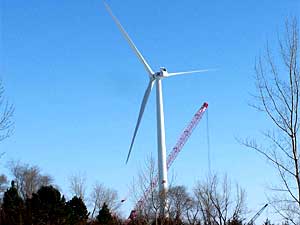|
Audio
Photos
Resources
|
April 22, 2005
Hydrogen is considered by many to be the answer to America's future energy needs. Someday it could be used to power cell phones,laptops, homes and even vehicles without pollution. And while hydrogen would help the country use less oil and gas, it still takes fossil fuels to make it. But researchers in western Minnesota hope a new project will clean up the process, and help the region become a major player in hydrogen production.
Collegeville, Minn. — People in the western Minnesota town of Morris can see the future of hydrogen production just outside of town. That's where a 230-foot tall wind turbine sits on the horizon. It's already in operation, using wind power to fill half of the energy needs at the nearby University of Minnesota campus. But there's hope that it can do much more.
Greg Cuomo heads up the U of M research center that houses the turbine. Cuomo says right now any extra power it produces is dumped onto the electrical grid, and used by a local power company.
"And that's fine but we think there's other uses for that excess electricity. One of the things we're looking at is to develop a wind to hydrogen project," Cuomo said.
Currently hydrogen is made in one of two ways. It's extracted from a fossil fuel like natural gas. Hydrogen can also be pulled out of water, but electricity is needed to do that, and quite often that power comes from burning fossil fuels. Cuomo says the sytem at Morris would be a cleaner way to make hydrogen.
"So we use the wind turbine to supply the energy through electrolysis to split water into hydrogen and oxygen. It's a very clean source of energy, hydrogen from another renewable source," Cuomo said.
The project could also solve wind power's biggest drawback. Turbines can only make electricity when the wind blows, that doesn't help the energy crunch on a hot, but calm, summer day.
University of Minnesota Professor Lanny Schmidt says making hydrogen from wind power is a good way to store electricity for when it's needed.
"There's no other way to store electricity. Batteries don't work. So that's the medium we have to look at," Schmidt said.
There's other ways to make hydrogen from renewable sources. Schmidt himself has studied extracting hydrogen from ethanol. Other research in Minnesota is looking at how hydrogen could be made with solar power, or by harvesting it from microbes.
Jeff Surfass, with the Washington D.C. based National Hydrogen Association, is excited with this exploration in hydrogen production. Surfass says for people concerned with the environment, making hydrogen from wind power makes sense.
"You can view hydrogen as the way to put wind power in your automobile fuel tank. It is that profound and important for our energy future," Surfass said
Hydrogen is being used experimentally to power a few buildings and automobiles across the country. But Surfass say research projects like the one at Morris, prove this is only the beginning for hydrogen.
"The activities going on in Minnesota are examples of the kinds of projects that are taking place in many places around the country. These are universities, in some cases companies in the region, seeing the opportunity and envisioning us at the beginning of a hydrogen transition, much like people might have with envisioned the vision of the electric age over 100 years ago," Surfass said. Serfass hopes hydrogen will power more and more consumer products over the years. But as far as running a car on the stuff, he says that's at least 15 years away.
No one assumes hydrogen will ever satisfy all of the country's energy needs. So in addition to studying how to use wind power to make hydrogen, the U of M researchers near Morris will also be studying the use of biomass. They say making electricity by burning wood chips, corn stalks and native grasses is another good use of the area's renewable resources.




